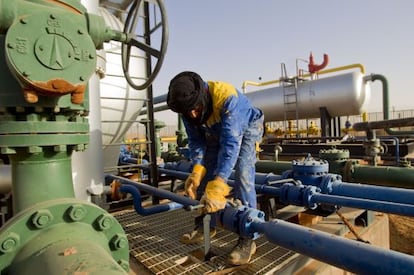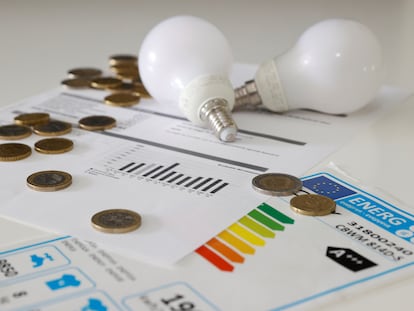Why the closure of an Algerian gas pipeline is bad news for Spain
With winter around the corner and the price of energy skyrocketing, Madrid has sent a minister to Algiers to seek assurances that supply will be guaranteed

With the price of gas, oil and coal climbing steadily in the international markets, and winter right around the corner, Spanish authorities are rushing to find a solution to the imminent closure of the Maghreb-Europe Gas Pipeline (MGE), a major source of natural gas for the Iberian peninsula.
Teresa Ribera, the Spanish ecological transition minister, traveled to Algeria on Wednesday to discuss the consequences of shutting down this source of energy at a time when finding an alternative supply is more complicated than ever.
Why is MGE being closed and why is it so important for Spain?
The 25-year MGE operation agreement expires this coming Sunday. Inaugurated in 1996, this pipe takes natural gas from Algeria to southern Spain along 1,400 kilometers that run through northwest Africa, crossing 540 kilometers of Moroccan territory along the way. But deteriorating relations between Algeria and Morocco have led Algiers to announce that the agreement will not be renewed.
Spain also receives natural gas from a second Algerian pipeline, Medgaz, but it is concerned that this source may not be able to make up for the shortfall. And a gas-supply shortage at this particular time would be a severe blow, as Spanish consumers are already reeling from the skyrocketing price of electricity, fuel and natural gas used for heating homes.
While other EU members such as Germany depend on gas from the Russian company Gazprom, which supplies a third of all gas in Europe, Spain imports from Algeria nearly half of all the natural gas it consumes in a year.
Spain does not need the gas just for industry and for heating systems. In fact, nearly a third of all electricity generated in Spain is made by combined-cycle power plants, which use natural gas. These facilities are a key back-up to renewable energy: when there is no sun and wind, the electricity supply falls back largely on burning natural gas and on nuclear plants, whose supply is always steady.
What are the alternatives?
There are two options to make up for the six billion cubic meters (bcm) of natural gas that normally reach Spain each year through the MGE pipeline. One would be to increase the capacity of the Medgaz pipeline, which goes straight from the gas fields of Hassi R’mel in Algeria to the southeastern Spanish city of Almería.
Medgaz was inaugurated a decade ago and it is controlled jointly by the Algerian state (51%) and by the Spanish energy company Naturgy, formerly known as Gas Natural Fenosa (49%). This pipeline provides a fourth of the natural gas that reaches Spain. Algeria has pledged to raise its capacity from eight bcm to 10 bcm a year, but Spain would still need around four bcm more to cover its needs. This could possibly be achieved by importing liquefied natural gas (LNG) on carrier ships.
Why is the timing so bad?
As the world slowly emerged from the coronavirus pandemic, main powers such as China rushed to increase their purchases of natural gas to avoid a supply crunch ahead of the cold winter months. Asia accounts for nearly three-quarters of global LNG imports, according to the financial firm AllianceBernstein. Prices have increased nearly fivefold since January, and demand for LNG carriers has also skyrocketed.
It would take around 50 such vessels to transport the four billion cubic meters required by Spain to make up for the shortfall from MGE that cannot be covered by Medgaz. It will not be easy to find so many carriers, and they will be expensive at a time of high demand. Also, the process of liquefying the gas and later returning it to a gaseous state is much more expensive than simply channeling it through a pipeline.
It’s not just Spain that’s in a bind. For Morocco, the MGE pipeline represented a significant source of income: as much as €200 million on a good year and €50 million on a bad one, depending on the volumes passing through. Rabat was also keeping some of that natural gas to generate around a tenth of its own electricity. Its diplomatic spat with Algeria over the disputed territory of Western Sahara could lead Morocco into an energy crisis of its own.
What can Morocco do to close its supply gap?
One option would be to ask Madrid to channel any leftover natural gas back to Morocco on the MGE pipeline, but it is unclear how Algeria would react to this. Rabat could also increase the amount of electricity it imports from Spain through two underwater cables, but the capacity for this kind of exchange between Morocco and Spain is less than 1% of all the electricity consumed in Spain.
Tu suscripción se está usando en otro dispositivo
¿Quieres añadir otro usuario a tu suscripción?
Si continúas leyendo en este dispositivo, no se podrá leer en el otro.
FlechaTu suscripción se está usando en otro dispositivo y solo puedes acceder a EL PAÍS desde un dispositivo a la vez.
Si quieres compartir tu cuenta, cambia tu suscripción a la modalidad Premium, así podrás añadir otro usuario. Cada uno accederá con su propia cuenta de email, lo que os permitirá personalizar vuestra experiencia en EL PAÍS.
¿Tienes una suscripción de empresa? Accede aquí para contratar más cuentas.
En el caso de no saber quién está usando tu cuenta, te recomendamos cambiar tu contraseña aquí.
Si decides continuar compartiendo tu cuenta, este mensaje se mostrará en tu dispositivo y en el de la otra persona que está usando tu cuenta de forma indefinida, afectando a tu experiencia de lectura. Puedes consultar aquí los términos y condiciones de la suscripción digital.
More information
Últimas noticias
Most viewed
- Sinaloa Cartel war is taking its toll on Los Chapitos
- Oona Chaplin: ‘I told James Cameron that I was living in a treehouse and starting a permaculture project with a friend’
- Reinhard Genzel, Nobel laureate in physics: ‘One-minute videos will never give you the truth’
- Why the price of coffee has skyrocketed: from Brazilian plantations to specialty coffee houses
- Silver prices are going crazy: This is what’s fueling the rally










































